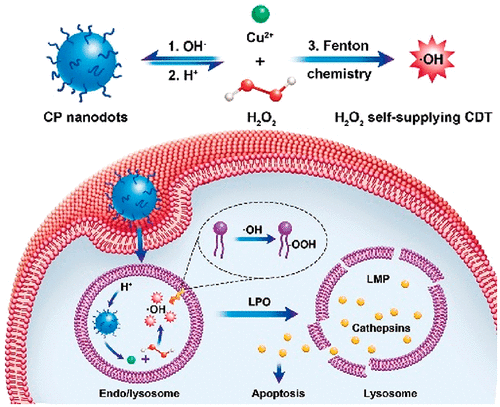当前位置:
X-MOL 学术
›
J. Am. Chem. Soc.
›
论文详情
Our official English website, www.x-mol.net, welcomes your
feedback! (Note: you will need to create a separate account there.)
Synthesis of Copper Peroxide Nanodots for H2O2 Self-Supplying Chemodynamic Therapy
Journal of the American Chemical Society ( IF 14.4 ) Pub Date : 2019-06-02 , DOI: 10.1021/jacs.9b03457 Li-Sen Lin 1 , Tao Huang 2 , Jibin Song 3 , Xiang-Yu Ou 3 , Zhangtong Wang 1 , Hongzhang Deng 1 , Rui Tian 1 , Yijing Liu 1 , Jun-Feng Wang 4 , Yuan Liu 1 , Guocan Yu 1 , Zijian Zhou 1 , Sheng Wang 1 , Gang Niu 1 , Huang-Hao Yang 3 , Xiaoyuan Chen 1
Journal of the American Chemical Society ( IF 14.4 ) Pub Date : 2019-06-02 , DOI: 10.1021/jacs.9b03457 Li-Sen Lin 1 , Tao Huang 2 , Jibin Song 3 , Xiang-Yu Ou 3 , Zhangtong Wang 1 , Hongzhang Deng 1 , Rui Tian 1 , Yijing Liu 1 , Jun-Feng Wang 4 , Yuan Liu 1 , Guocan Yu 1 , Zijian Zhou 1 , Sheng Wang 1 , Gang Niu 1 , Huang-Hao Yang 3 , Xiaoyuan Chen 1
Affiliation

|
Chemodynamic therapy (CDT) employs Fenton catalysts to kill cancer cells by converting intracellular H2O2 into hydroxyl radical (•OH), but endogenous H2O2 is insufficient to achieve satisfactory anticancer efficacy. Despite tremendous efforts, engineering CDT agents with specific and efficient H2O2 self-supplying ability remains a great challenge. Here, we report the fabrication of copper peroxide (CP) nanodot, which is the first example of a Fenton-type metal peroxide nanomaterial, and its use as an activatable agent for enhanced CDT by self-supplying H2O2. The CP nanodots were prepared through coordination of H2O2 to Cu2+ with the aid of hydroxide ion, which could be reversed by acid treatment. After endocytosis into tumor cells, acidic environment of endo/lysosomes accelerated the dissociation of CP nanodots, allowing simultaneous release of Fenton catalytic Cu2+ and H2O2 accompanied by a Fenton-type reaction between them. The resulting •OH induced lysosomal membrane permeabilization through lipid peroxidation and thus caused cell death via a lysosome-associated pathway. In addition to pH-dependent •OH generation property, CP nanodots with small particle size showed high tumor accumulation after intravenous administration, which enabled effective tumor growth inhibition with minimal side effects in vivo. Our work not only provides the first paradigm for fabricating Fenton-type metal peroxide nanomaterials, but also presents a new strategy to improve CDT efficacy.
中文翻译:

用于 H2O2 自供化学动力学治疗的过氧化铜纳米点的合成
化学动力学疗法 (CDT) 使用芬顿催化剂通过将细胞内的 H2O2 转化为羟基自由基 (•OH) 来杀死癌细胞,但内源性 H2O2 不足以达到令人满意的抗癌效果。尽管付出了巨大的努力,但设计具有特定和高效 H2O2 自给能力的 CDT 代理仍然是一个巨大的挑战。在这里,我们报告了过氧化铜 (CP) 纳米点的制造,这是芬顿型金属过氧化物纳米材料的第一个例子,并将其用作通过自供 H2O2 增强 CDT 的可活化剂。CP纳米点是通过在氢氧根离子的帮助下将H2O2配位为Cu2+而制备的,这可以通过酸处理来逆转。内吞进入肿瘤细胞后,内/溶酶体的酸性环境加速了CP纳米点的解离,允许同时释放芬顿催化 Cu2+ 和 H2O2,伴随着它们之间的芬顿型反应。由此产生的•OH 通过脂质过氧化作用诱导溶酶体膜透化,从而通过溶酶体相关途径导致细胞死亡。除了pH依赖性•OH生成特性外,小粒径CP纳米点在静脉给药后显示出高肿瘤积累,这能够有效抑制肿瘤生长,并且在体内副作用最小。我们的工作不仅为制造芬顿型金属过氧化物纳米材料提供了第一个范例,而且还提出了一种提高 CDT 功效的新策略。由此产生的•OH 通过脂质过氧化作用诱导溶酶体膜透化,从而通过溶酶体相关途径导致细胞死亡。除了pH依赖性•OH生成特性外,小粒径CP纳米点在静脉给药后显示出高肿瘤积累,这能够有效抑制肿瘤生长,并且在体内副作用最小。我们的工作不仅为制造芬顿型金属过氧化物纳米材料提供了第一个范例,而且还提出了一种提高 CDT 功效的新策略。由此产生的•OH 通过脂质过氧化作用诱导溶酶体膜透化,从而通过溶酶体相关途径导致细胞死亡。除了pH依赖性•OH生成特性外,小粒径CP纳米点在静脉给药后显示出高肿瘤积累,这能够有效抑制肿瘤生长,并且在体内副作用最小。我们的工作不仅为制造芬顿型金属过氧化物纳米材料提供了第一个范例,而且还提出了一种提高 CDT 功效的新策略。
更新日期:2019-06-02
中文翻译:

用于 H2O2 自供化学动力学治疗的过氧化铜纳米点的合成
化学动力学疗法 (CDT) 使用芬顿催化剂通过将细胞内的 H2O2 转化为羟基自由基 (•OH) 来杀死癌细胞,但内源性 H2O2 不足以达到令人满意的抗癌效果。尽管付出了巨大的努力,但设计具有特定和高效 H2O2 自给能力的 CDT 代理仍然是一个巨大的挑战。在这里,我们报告了过氧化铜 (CP) 纳米点的制造,这是芬顿型金属过氧化物纳米材料的第一个例子,并将其用作通过自供 H2O2 增强 CDT 的可活化剂。CP纳米点是通过在氢氧根离子的帮助下将H2O2配位为Cu2+而制备的,这可以通过酸处理来逆转。内吞进入肿瘤细胞后,内/溶酶体的酸性环境加速了CP纳米点的解离,允许同时释放芬顿催化 Cu2+ 和 H2O2,伴随着它们之间的芬顿型反应。由此产生的•OH 通过脂质过氧化作用诱导溶酶体膜透化,从而通过溶酶体相关途径导致细胞死亡。除了pH依赖性•OH生成特性外,小粒径CP纳米点在静脉给药后显示出高肿瘤积累,这能够有效抑制肿瘤生长,并且在体内副作用最小。我们的工作不仅为制造芬顿型金属过氧化物纳米材料提供了第一个范例,而且还提出了一种提高 CDT 功效的新策略。由此产生的•OH 通过脂质过氧化作用诱导溶酶体膜透化,从而通过溶酶体相关途径导致细胞死亡。除了pH依赖性•OH生成特性外,小粒径CP纳米点在静脉给药后显示出高肿瘤积累,这能够有效抑制肿瘤生长,并且在体内副作用最小。我们的工作不仅为制造芬顿型金属过氧化物纳米材料提供了第一个范例,而且还提出了一种提高 CDT 功效的新策略。由此产生的•OH 通过脂质过氧化作用诱导溶酶体膜透化,从而通过溶酶体相关途径导致细胞死亡。除了pH依赖性•OH生成特性外,小粒径CP纳米点在静脉给药后显示出高肿瘤积累,这能够有效抑制肿瘤生长,并且在体内副作用最小。我们的工作不仅为制造芬顿型金属过氧化物纳米材料提供了第一个范例,而且还提出了一种提高 CDT 功效的新策略。































 京公网安备 11010802027423号
京公网安备 11010802027423号